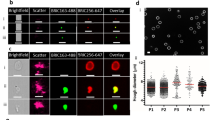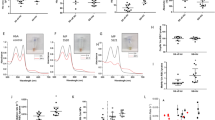Abstract
Much recent interest in the mechanism of dehydration of the dense subpopulation of sickle-cell anaemia (SS) red cells, including the ‘irreversibly sickled cells’ (ISCs), stems from the view that these relatively rigid cells have a major role in the two main clinical features of the disease, namely haemolytic anaemia and microvascular occlusion1. The discovery that SS red cells have an elevated calcium content and accumulate Ca2+ during deoxygenation-induced sickling2–4 suggested a working hypothesis of wide appeal for the mechanism of cell dehydration: retained calcium would activate the red cell Ca2+-sensitive K+ channels5, causing progressive net loss of KCl and water6–8. However, retained calcium, which seemed as weakly bound to cytoplasmic buffers as in normal red cells9, failed to show any measurable activation of K+ channels or Ca2+ pumps in metabolically normal SS cells, despite the apparent functional normality or near-normality of these transport systems9–17. We now offer a possible explanation for this failure. We show that, contrary to the traditional views, SS cells, and to a lesser extent normal human red cells, possess intracellular vesicles with ATP-dependent Ca2+-accumulating capacity, and that nearly all the measurable calcium of fresh SS cells is contained within such vesicles, probably in the form of precipitates with inorganic or organic phosphates.
This is a preview of subscription content, access via your institution
Access options
Subscribe to this journal
Receive 51 print issues and online access
$199.00 per year
only $3.90 per issue
Buy this article
- Purchase on Springer Link
- Instant access to full article PDF
Prices may be subject to local taxes which are calculated during checkout
Similar content being viewed by others
References
Bookchin, R. M. & Lew, V. L. Prog. Hemat. 13, 1–23 (1983).
Eaton, J. W., Skelton, T. D., Swofford, H. S., Kolpin, C. E. & Jacob, H. S. Nature 246, 105–106 (1973).
Palek, J. Blood 42, 988 (1973).
Palek, J. J. Lab. clin. Med. 89, 1365–1374 (1977).
Gardos, G. Biochim. biophys. Acta 30, 653–654 (1958).
Eaton, J. W., Berger, E., White, J. G. & Jacob, H. S. Br. J. Haemat. 38, 57–62 (1978).
Glader, B. E. & Nathan, D. G. Blood 51, 983–989 (1978).
Berkowitz, L. R. & Orringer, E. P. J. clin. Invest. 68, 1215–1220 (1981).
Lew, V. L. & Bookchin, R. M. Biochim. biophys. Acta 602, 196–200 (1980).
Bookchin, R. M. & Lew, V. L. Nature 284, 561–563 (1980).
Bookchin, R. M., Ortiz, O. E. & Lew, V. L. in Proc. 6th int. Conf. Red Cell Metabolism and Function (ed. Brewer, G. J.) 17–28 (Liss, New York, 1984).
Bookchin, R. M., Raventos, C. & Lew, V. L. in 5th Ann Arbor Conf. (ed. Brewer, G. J.) 163–182 (Liss, New York, 1981).
Gopinath, R. M. & Vincenzi, F. F. Am. J. Hemat. 7, 303–312 (1979).
Litosch, I. & Lee, K. S. Am. J. Hemat. 8, 377–387 (1980).
Dixon, E. & Winslow, R. M. Br. J. Haemat. 47, 391–397 (1981).
Niggli, V., Adunyah, E. S., Cameron, B. F., Bababunmi, E. A. & Carafoli, E. Cell Calcium 3, 131–151 (1982).
Luthra, M. G. & Sears, D. A. Blood 60, 1332–1336 (1982).
Kent, G., Minick, O. T., Volini, F. I. & Orfei, E. Am. J. Path. 48, 831–857 (1966).
Holroyde, C. P. & Gardner, F. H. Blood 36, 566–575 (1980).
Somlyo, A. V., Gonzalez-Serratos, H., Shuman, H., McClellan, G. & Somlyo, A. P. J. Cell Biol. 90, 577–594 (1981).
Shuman, A., Somlyo, A. V. & Somlyo, A. P. Ultramicroscopy 1, 317–339 (1976).
Lew, V. L. & Seymour, C. A. in Techniques in Lipid and Membrane Chemistry (eds Kornberg, H. L. et al.) (Elsevier, Amsterdam).
Ohnishi, S. T. Br. J. Haemat. 55, 665–671 (1983).
Larsen, F. L., Katz, S., Roufogalis, B. D. & Brooks, D. E. Nature 294, 667–668 (1981).
Pearson, H. A., Spencer, R. P. & Cornelius, E. A. New Engl. J. Med. 281, 923–926 (1969).
Stempak, J. G. & Ward, R. T. J. Cell Biol. 22, 697–701 (1964).
Kitazawa, T., Shuman, H. & Somlyo, A. P. Ultramicroscopy 11, 251–262 (1983).
Clark, M. R., Unger, R. S. & Shohet, S. B. Blood 51, 1169–1178 (1978).
Author information
Authors and Affiliations
Rights and permissions
About this article
Cite this article
Lew, V., Hockaday, A., Sepulveda, MI. et al. Compartmentalization of sickle-cell calcium in endocytic inside-out vesicles. Nature 315, 586–589 (1985). https://doi.org/10.1038/315586a0
Received:
Accepted:
Issue Date:
DOI: https://doi.org/10.1038/315586a0
Comments
By submitting a comment you agree to abide by our Terms and Community Guidelines. If you find something abusive or that does not comply with our terms or guidelines please flag it as inappropriate.



